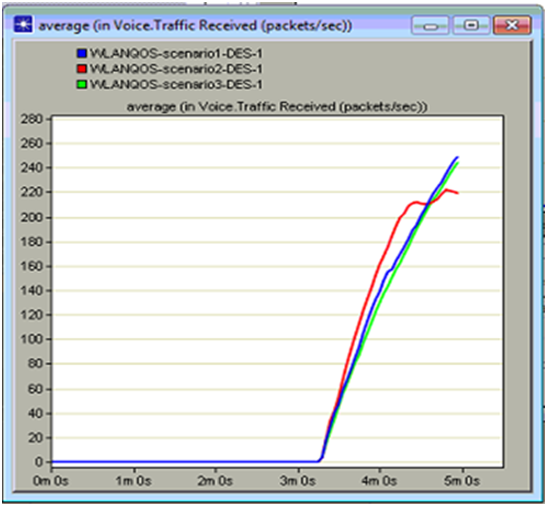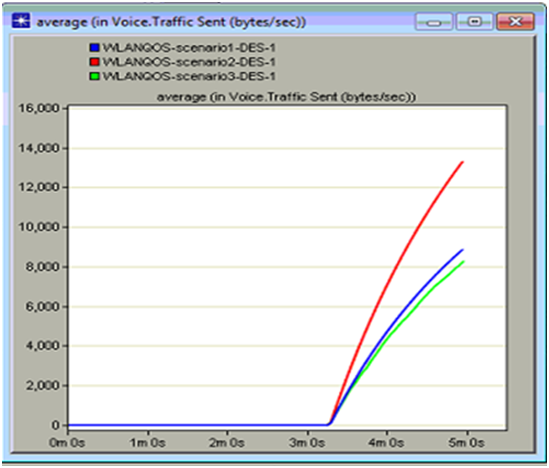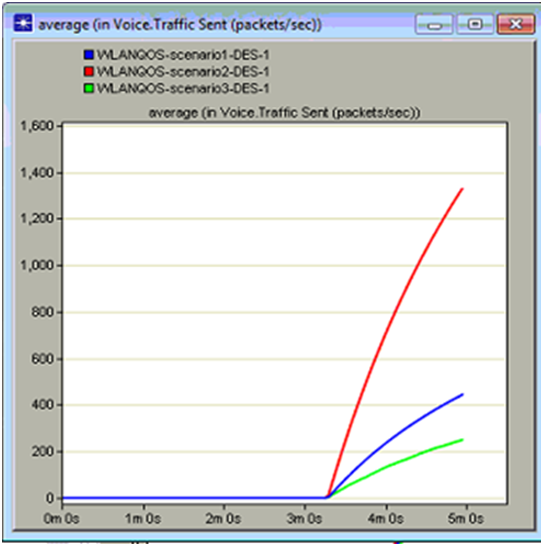Traffic received in packets per second
Traffic received in packets per second indicates the overall performance of the network in terms of number of packets delivered at the voice destination side. In general if more packets are delivered across the network then the overall quality of service requirements are enhanced and thus in this case the overall traffic received across the three scenarios is given in the below comparison graph
From this Project Abstract it is clear that the overall traffic received is more with the GSM and even the value is constant across the simulation. From the comparison of the three scenarios it is clear that the overall traffic received in packets per second is more with the GSM speech and also the value is constant when compared to all the other two scenarios.
When the traffic received is more it indicates the overall performance of the network is increased in terms of quality delivery and thus from this comparison process it is clear even the traffic received is more with the low quality speech and this indicates that at the idle conditions the low quality speech is increased in terms of the traffic received and thus the overall quality of service is increased due to the traffic received. Even from this simulation process this indicates that the GSM quality speech is required to ensure the best quality of service requirements.
Traffic sent in byte per second
Traffic sent indicates the overall traffic sent by the nodes towards the destination and thus even the quality of service requirements purely depends on the traffic sent in bytes per second. As three applications are used in this process the overall traffic sent in bytes per second against the three applications is shown in the below screen
The overall traffic sent across the network in bytes per second by the three scenarios is shown in the above screen. From the analysis if the average traffic sent it is clear that the overall traffic sent is more with the IP telephony and this is due to the reason that the telephony applications impose more traffic by the nodes and with this much traffic the overall traffic sent is increased and the nodes loose the core compatibility of against the quality of service requirements.
A low traffic is sent with the GSM quality speech and this indicates that the quality of service requirements across the voice application can be increased due to the GSM quality speech. The traffic sent by the low quality speech is also more when compared to GSM and thus even a constant traffic sent and thus the overall quality of service requirements is perfect for the GSM quality speech even in this case.
Traffic sent in packets per second
Traffic sent in packets per seconds indicates the total number of packets send across the network due to voice application impose across the network. In this context the three scenarios are compared for the traffic sent in packets per second and the resultant graph is shown as below
From this Project Abstract it is clear that even the traffic sent in packets per second is more with the IP telephony when compared to low quality and GSM speech. When the traffic sent in packets per second is compared a more traffic is sent is with the IP telephony and thus the overall quality of service is reduced a lot and also the value has started after 3 minutes of simulation time.
When the case with the GSM is considered the overall traffic sent is very low and this indicates that the quality of service requirements are enhanced with the GSM speech and even in this case the GSM is proved to be the best quality of service requirements imposed for the voice applications.



